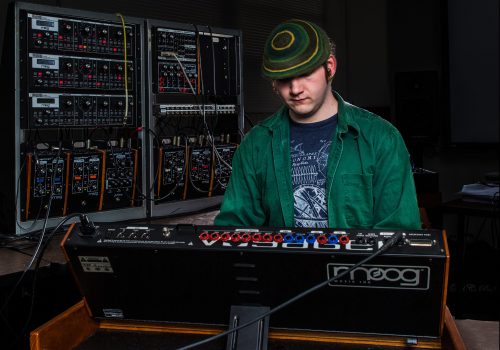In December 2009, UNC Asheville’s Bob Moog Electronic Music Studio was dedicated to Dr. Moog, the late electronic music pioneer and inventor of the Moog Synthesizer. Dr. Moog was a Research Professor of Music at UNC Asheville.
Tinkering in his New York City apartment in the 1950s, a young Robert “Bob” Moog had no idea that he was about to change the face of popular music forever. The brainy teenager had been fascinated with electronics since childhood. Inspired by a magazine advertisement, he took up building theremins, the electronic musical instrument comprised of two metal rods around which musicians move their hands to create high-pitched eerie sounds popularized in early sci-fi and horror movies.
In 1954, he founded the R.A. Moog Company as a part-time business focused on building and selling theremins and other funky electronic instruments to help fund his way through college. By the time he had earned a doctorate in engineering physics from Cornell University, Moog’s business was a full-time venture – and music hasn’t been the same since.
The engineer essentially turned electricity into music. Moog created the electronic music synthesizer that bears his name and that became widespread among experimental composers and rock musicians. His earliest instruments were large machines better suited to studio work than live performances, but as rock bands adopted them, Moog expanded his product line to include smaller and smaller instruments that could be used more easily on stage.
The innovative sounds of the Moog synthesizer were featured on the 1968 Top Ten album Switched on Bach. Immediately the synthesizer became the must-have tool for bands. It was used by the Beatles on several Abbey Road album tracks as well as on tunes by The Monkees, Stevie Wonder and Pink Floyd. In fact, it became the force behind generations of new music – from 1980s New Wave to 21st century techno.
In 1978, Moog moved from New York to Asheville and started a new company that produced synthesizer modules. As he continued to build and create, his instruments became mainstream, turning up not only in recording studios but also in homes and classrooms.
UNC Asheville was uniquely positioned to take advantage of Moog’s expertise. He began presenting workshops and lectures on campus not long after his move to Western North Carolina. Eventually, the bushy-haired engineer joined the Music Department faculty and served as Visiting Research Professor.
“The students were in awe,” said Wayne Kirby, UNC Asheville Music Department Chair and Professor, who hired Moog in 1989. “It was like being taught by Thomas Edison.”
Students came from around the country and around the world to study with Moog. He taught a number of courses, including “Synthesizers and Music Software,” “Electronic Music Seminar” and “Electronic Music Practicum.” Kirby noted that the pioneer-turned-professor had a tough teaching style. “He was demanding in a humane kind of way,” Kirby said. “He expected as much out of his students as he expected out of himself.”
Moog retired from full-time teaching in 1993 and went back to work tinkering with electronics until his death. Moog died in 2005 at the age of 71 from an inoperable brain tumor. Musicians around the world mourned, and the New York Times eulogized Moog with a half-page obituary. Memorial concerts were held, and a foundation was established to preserve his archives.
Now, a newly expanded and refurbished music studio on campus further honors him. The Bob Moog Electronic Music Studio, located on the lower level of Lipinsky Hall, was dedicated in December 2009. For years to come, students who study and work in the studio will uphold the legacy of the music pioneer and professor who left an indelible stamp on the recording industry and on UNC Asheville. Designed as a creative workspace, today it is filled with Moog, Make Noise, Yamaha, Casio, and Haken synthesizers.
